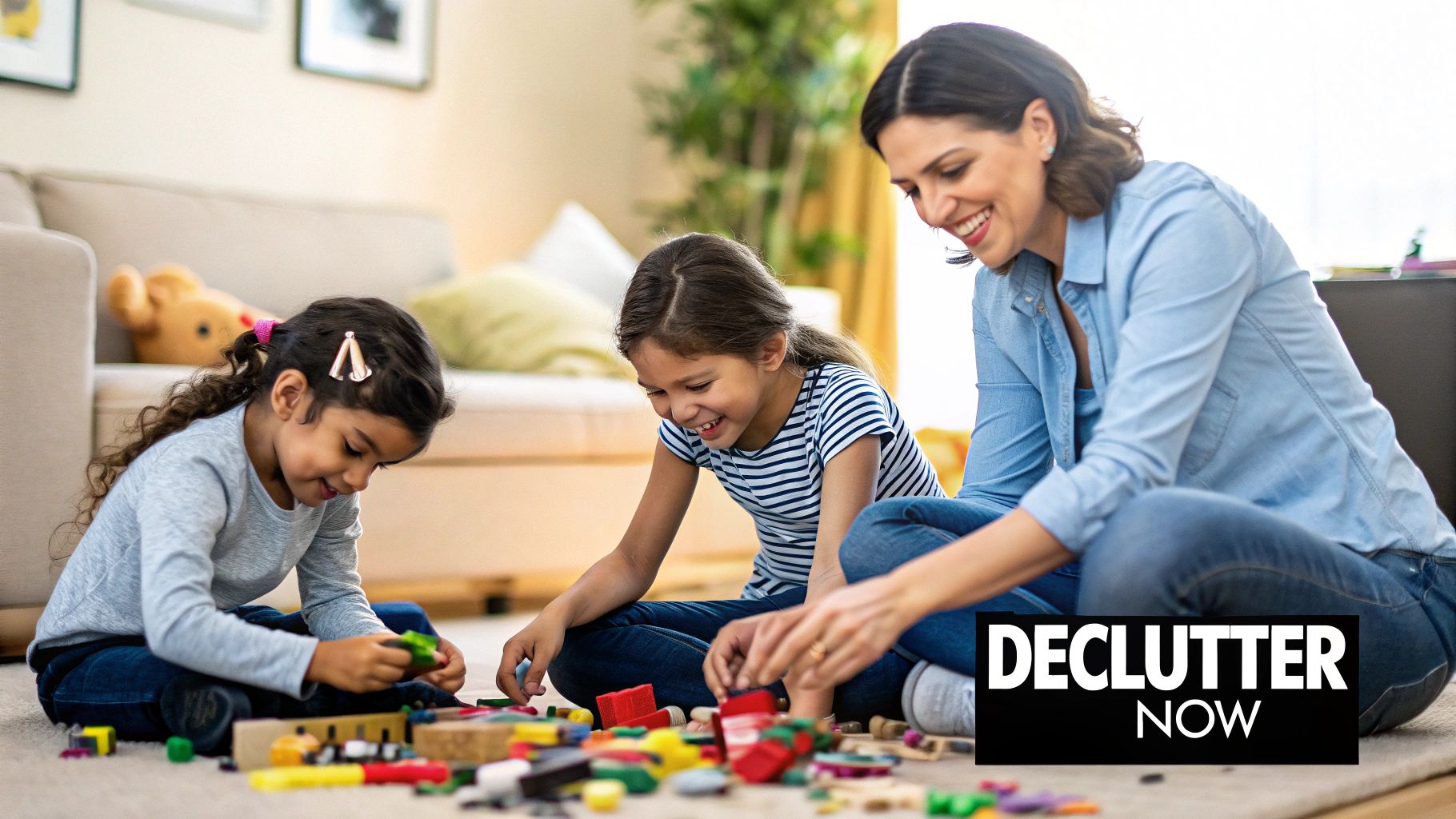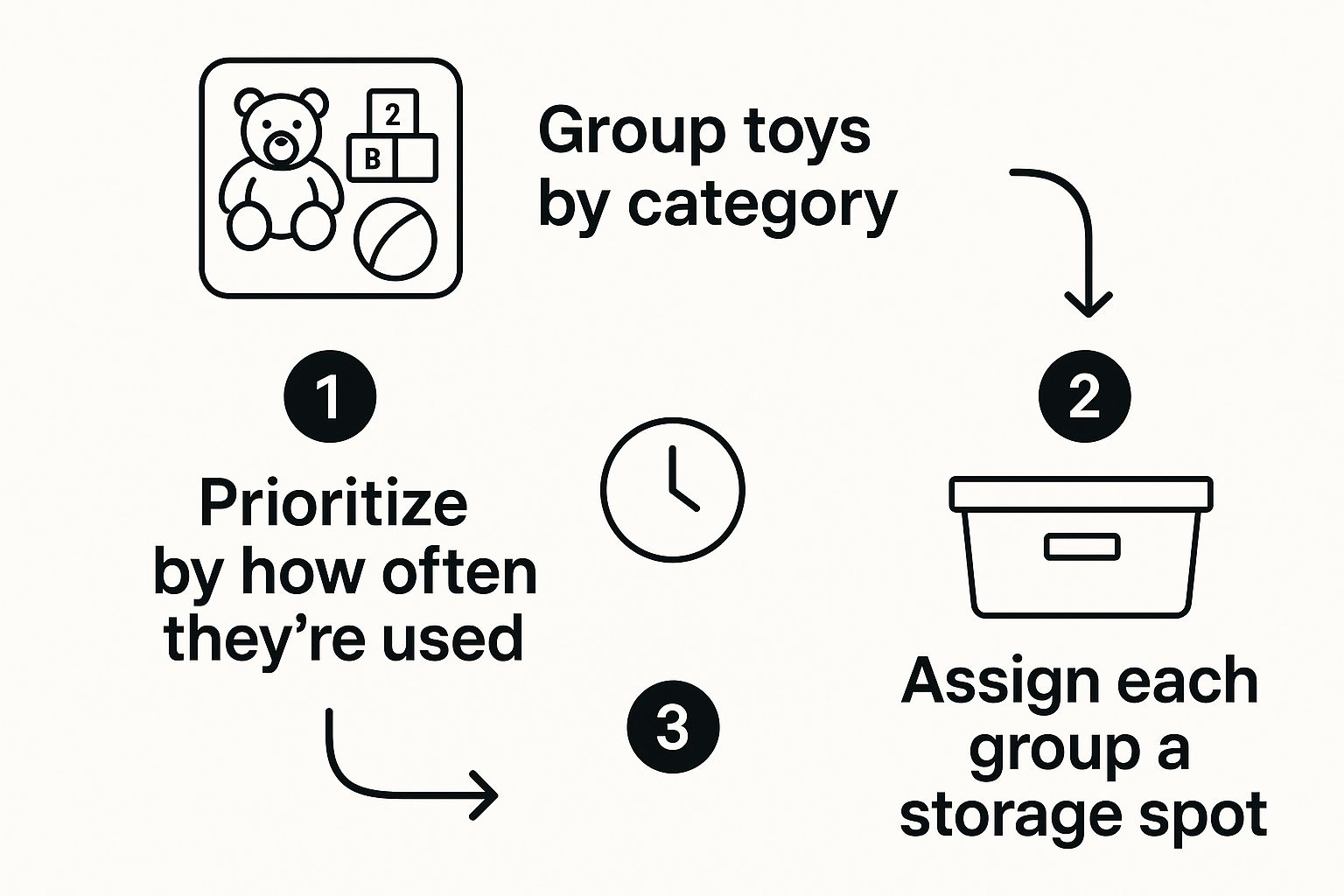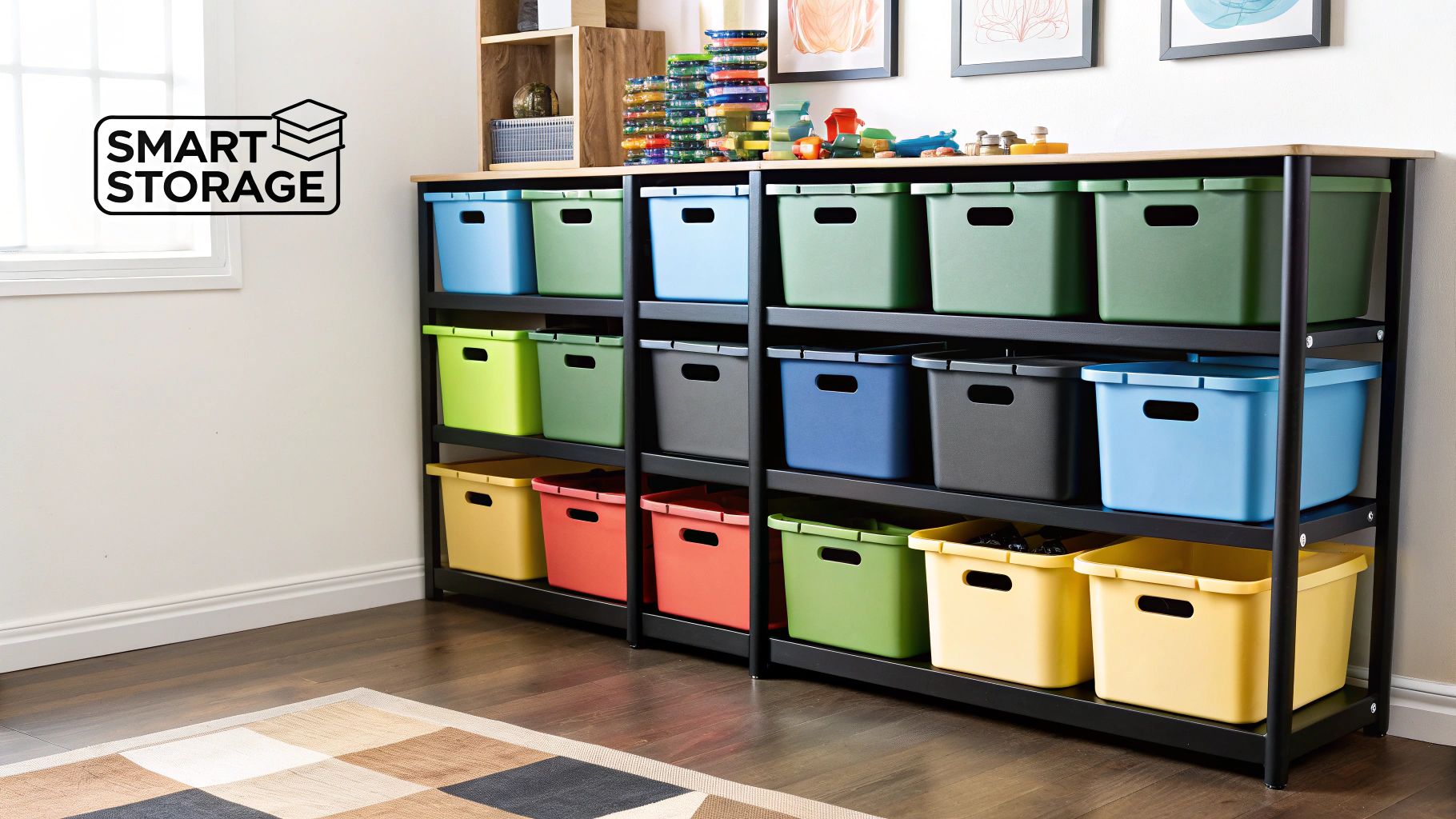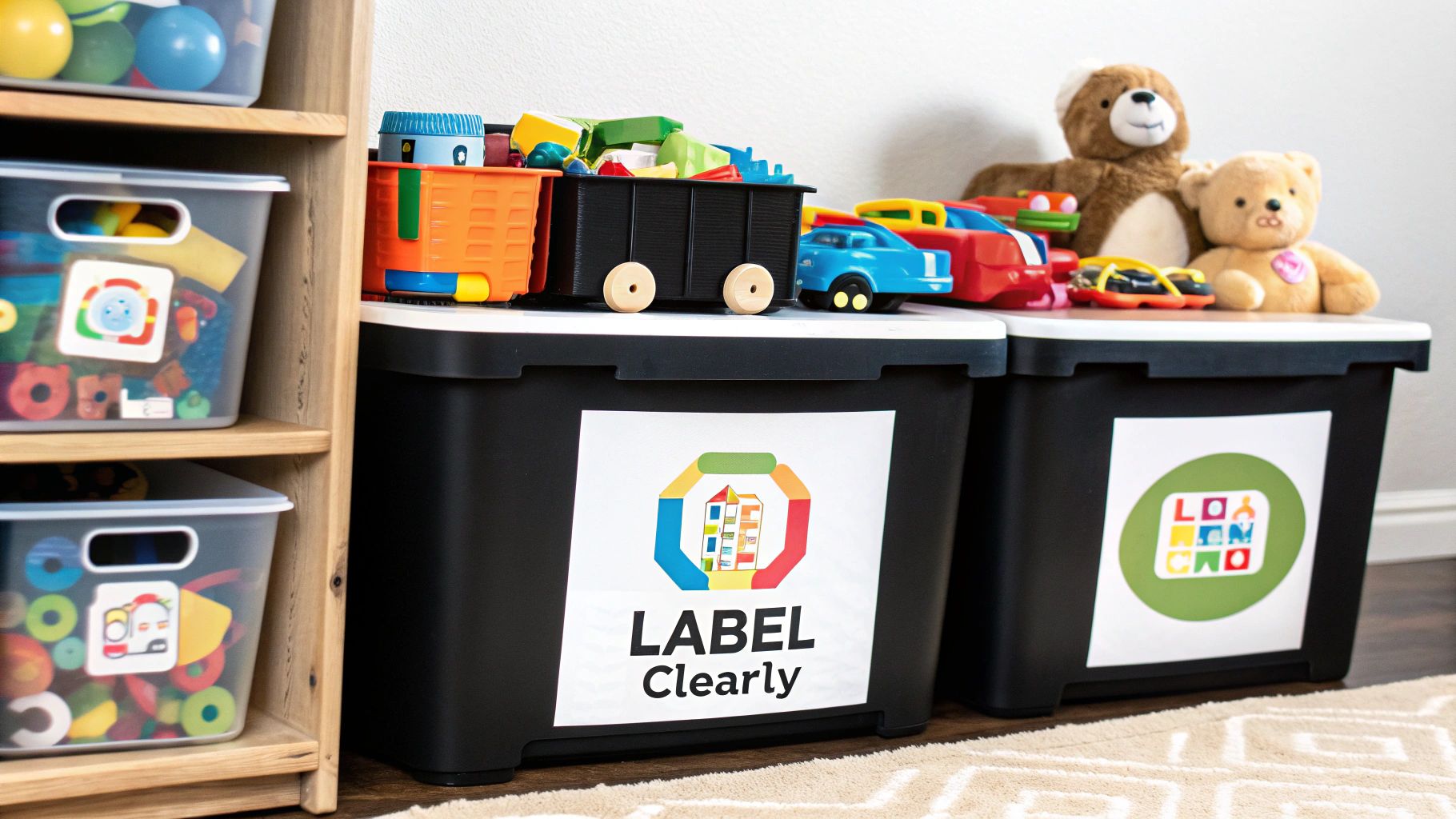
How to Organize Kids Toys: Easy Tips for a Tidy Playroom
Share
Let’s be honest: if your living room floor has become a permanent obstacle course of LEGOs, dolls, and half-finished puzzles, you are in good company. That feeling of being totally swamped by the sheer volume of stuff is a universal parent experience.
This guide isn't about creating a sterile, picture-perfect playroom that no one actually uses. It’s about building a real, functional system to finally get a handle on the toy chaos for good.
Conquering the Toy Chaos for Good

Taming the toy monster is about more than just a clean house. When a play space is organized, it genuinely helps our kids.
- Fosters Creativity: It’s simple—when kids can actually find their toys, they’re more likely to dive into deep, imaginative play.
- Improves Focus: Less visual clutter means fewer distractions, helping them concentrate on one thing at a time.
- Teaches Responsibility: A clear system empowers them to clean up after themselves. They know where things go, which is half the battle.
The Four Pillars of Toy Organization at a Glance
I’ve built my entire approach around four core ideas: Declutter, Categorize, Contain, and Maintain. This isn't a quick fix; it's a sustainable system designed for busy families. We'll get into the nitty-gritty of each step, but this table gives you a bird's-eye view of the game plan.
| Principle | What It Means | Why It Matters |
|---|---|---|
| Declutter | The big purge. We’ll sort through every single toy to decide what’s worth keeping. | This makes the rest of the process a thousand times easier and leaves you with only the toys your kids truly love. |
| Categorize | Grouping like with like. Think "all the cars together" or "all the art supplies." | It creates a logical home for everything, which is key for getting kids to help with cleanup. |
| Contain | Finding the right home for each category—bins, baskets, shelves, you name it. | Good storage makes tidying up quick and keeps toys accessible (but not all over the floor). |
| Maintain | Building simple routines to keep things from spiraling back into chaos. | This is how you make it last. It’s about creating small, consistent habits for the whole family. |
Think of these four pillars as your roadmap out of the clutter. It’s a repeatable process that will serve you well for years to come.
And let's face it, this challenge is only getting bigger. The global toy market is massive, projected to hit $111.8 billion in annual sales. That translates to more and more toys finding their way into our homes, making a smart organization plan essential. If you're working with a smaller footprint, finding the right storage becomes even more crucial. For some great ideas, check out our guide on the best furniture for small spaces to make every inch count.
Decluttering Toys Without the Tears
This is where the magic really happens. Before you even think about buying a single bin or printing a label, you have to face the toy mountain head-on. This first step is absolutely crucial because it ensures you’re only finding homes for the toys your kids actually love and play with.
The idea isn't about becoming a minimalist overnight. It's about curating a collection of toys that sparks creativity and joy, not stress and overwhelm. You're simply making room for more meaningful play.
The Four-Box Method for Sorting
I’ve found the most effective (and least painful) way to tackle the toy pile is with four distinct containers. Grab some empty boxes, laundry baskets, or even just create four piles on the floor. Label them: Keep, Rotate, Donate, and Discard. This simple system makes you decide the fate of every single item.
- Keep: These are the all-stars—the toys that see action daily or weekly. They’re the foundation of your child's play world and earn their prime real estate.
- Rotate: This is my secret weapon for forgotten-but-still-good toys. Tucking them away for a few months and bringing them out later makes them feel brand new again.
- Donate: This pile is for toys that are still in great shape but have been outgrown or just aren't a favorite anymore. It’s also a perfect opportunity to talk about generosity.
- Discard: Let’s be real—some toys are just done. Anything broken beyond repair, missing essential pieces, or just plain gross goes here. Don't feel guilty.
This process chart gives a great visual for how this works in practice. Once you group things, you prioritize them, and then you can figure out where they should live.

As you can see, once you’ve sorted similar items into groups, deciding which ones are high-priority makes finding the right storage spot so much easier.
Navigating the Process with Kids
Bringing your kids into the decluttering process can be fantastic, but you need a game plan. Just pointing to a room and saying, "Time to get rid of stuff!" is a one-way ticket to a full-blown meltdown.
Instead, frame it as a positive mission. Try saying something like, "Let's make some space for the new toys you might get for your birthday!" or "I bet we could find some great toys to share with kids who don't have as many. Which ones do you think would make another child really happy?" When you give them a sense of control and purpose, the whole dynamic shifts.
For younger kids, I highly recommend pre-sorting. Pull out a small group of toys you know they haven't touched in months and let them pick just one or two from that pile to donate. It gives them a manageable choice without overwhelming them.
A key takeaway here is to turn decluttering into a life lesson. By involving children in donating, you're teaching them empathy, generosity, and the idea that our belongings have a life beyond our own playroom.
Overcoming Parental Guilt
Okay, let's be honest. Sometimes this whole process is way harder for us than it is for our kids. The guilt can be a real struggle, especially when you're looking at an expensive toy that was barely touched or a gift from a well-meaning grandparent.
Here's something to remember: a toy that isn't being played with is just clutter. It doesn't matter what it cost or who gave it. Its real value is in the joy and play it brings, not in its mere presence on a shelf. If a gifted toy never quite clicked with your child, it has already served its purpose—it was a thoughtful gesture. It's perfectly okay to pass it on to a new home where it will be truly loved and used.
What about those super sentimental items, like a handmade doll from Grandma? Think about its function. If it’s not really for playing, could it be displayed on a shelf as a special keepsake? If there's no good spot for it, take a photo to preserve the memory and then let the physical item go. Your goal is a functional, joyful space, and that means being honest about what truly belongs there.
Creating a Toy System That Makes Sense

Alright, you’ve sorted through the mountain and are left with the toys your kids truly love. Now comes the fun part: building a system to keep the chaos from creeping back in.
This isn't just about finding a home for every toy. The goal is to create a framework that’s so intuitive your kids can actually use it themselves. When they can find what they want and—more importantly—put it away on their own, that’s a real win.
A good system has to make sense to a kid's brain. Forget the hyper-specific labels that only make sense to adults (no one needs a bin for "Jurassic-era dinosaur figurines"). Just call it "Dinosaurs." Simple. Broad. Logical.
Choose Your Sorting Strategy
There’s no magic formula here. The "right" way to categorize toys really depends on your family's collection and, most importantly, how your kids play. Your mission is to pick the method that clicks with them, as this will be the foundation of your entire organization system.
Here are a few proven approaches I've seen work time and time again:
- Sort by Type: This is the classic method and for good reason—it’s easy for kids to grasp. All the cars go in one bin, all the blocks in another, and dolls get their own basket. It’s clean, straightforward, and hard to mess up.
- Sort by Activity: This is great for grouping items that are always used together. Think of an "art station" with crayons, paper, and scissors all in one spot, or a "building zone" with LEGOs, Magna-Tiles, and wooden blocks in nearby containers.
- Sort by Play Zone: If you have the space, you can create designated areas for different types of play. This might look like a cozy reading nook with books and pillows, a corner for imaginative play with a kitchen and dress-up clothes, or a table dedicated to puzzles and games.
The most effective toy organization systems are the ones children can maintain themselves. If a child has to ask where a toy goes, the system is likely too complicated. Simplicity is your greatest ally.
The best way to figure this out is to just observe your kids for a day or two. Do they dump out all the vehicles at once? Sorting by type is probably your best bet. Do they love setting up elaborate scenes with different building materials? An "activity" or "zone" approach might be perfect.
Aligning Categories with Play Trends
It can also be helpful to think about which toys get the most action. Prioritizing the most popular play categories can make a huge difference in how you set things up.
Recent data shows some interesting trends. For example, games and puzzles saw a massive 36% growth in sales, with explorative toys growing by 13% and building sets by 12%. This tells us that kids are deeply engaged in these activity-based toys. Knowing this reinforces the value of creating specific, easy-to-access stations for puzzles or building projects.
Practical Examples of Toy Categories
So, what does this actually look like in a real home? Let’s get practical. Here’s how you might break things down:
- Building Things: LEGOs, Magna-Tiles, wooden blocks, train tracks.
- Creating Things: Art supplies (crayons, paint, glue), Play-Doh, craft kits.
- Imaginary Play: Dolls, action figures, dress-up clothes, play food.
- Quiet Time: Puzzles, board games, books.
- Things That Go: Cars, trucks, airplanes.
For those tiny collections—like doll shoes or special LEGO pieces—try using smaller pouches or containers inside the larger bins to keep them from getting lost.
And if you’re looking for a storage solution that doesn’t scream “toy bin,” a beautiful woven container like this apple-shaped storage basket is perfect for holding things like play silks or wooden animals while blending right in with your decor.
Choosing the right container for each category is half the battle. To make it a little easier, here’s a quick guide to matching storage solutions with common types of toys.
Best Storage Solutions for Common Toy Categories
| Toy Category | Recommended Storage Solution | Why It Works |
|---|---|---|
| Building Blocks & LEGOs | Large, open-top bins or play mats that double as storage bags. | Makes it easy for kids to see everything and scoop items up during cleanup. |
| Art Supplies | Clear, sectioned organizers or a rolling cart with multiple tiers. | Keeps small items like crayons, markers, and scissors separate and visible. |
| Dolls & Action Figures | Fabric baskets or clear plastic bins with lids. | Baskets are soft and easy for little hands to access; clear bins help them find a specific character. |
| Puzzles & Board Games | Vertical shelving or zippered pouches for puzzle pieces. | Storing games vertically like books saves space and makes it easy to grab one without toppling a stack. |
| Stuffed Animals | Woven baskets, hanging mesh nets, or a fabric "bean bag" chair cover. | Keeps them contained but still visible and accessible for cuddles. |
Picking the right container really does set your system up for success. When cleanup is as simple as tossing blocks into a big basket, kids are far more likely to do it themselves.
Finding the Right Home for Every Toy

Now that you’ve sorted through the mountain of toys, it’s time for the fun part: giving everything a proper home. The right storage isn’t just about hiding clutter. It’s about creating a system that actually works for your kids, making it easy for them to find what they want and—dare I say it—put things away on their own.
Let’s be real: we're aiming for a livable, usable space, not a sterile showroom. The goal is to make cleanup less of a battle for a tired toddler or a distracted big kid.
Make Toys Visible and Easy to Grab
When it comes to kids, "out of sight, out of mind" is a universal truth. If they can't see their toys, they won't play with them. That's why the simplest storage solutions are often the most effective.
Here are a few of my go-to options that have never failed me:
- Cube Shelves: These are the undisputed champions of toy organization. They're incredibly versatile, won't break the bank, and are perfect for housing everything from fabric bins to woven baskets. You can also leave some cubes open for bulkier items like toy garages or dollhouses.
- Clear Bins: An absolute lifesaver for anything with a million little pieces. Think LEGOs, Magna-Tiles, or art supplies. Kids can see exactly what’s inside without dumping the entire container on the floor just to find one red brick.
- Open-Front Bins: These are fantastic for the toys that get played with daily, like blocks, cars, or animal figures. The scoop-front design makes it a breeze for little hands to grab what they need and toss it back in when they're done.
If you need something that blends in with your living room decor, a good set of utility baskets is a game-changer. They're stylish enough for a common area and perfect for stashing stuffed animals, blankets, or dress-up clothes.
My golden rule for kid-friendly storage? Keep the most-loved toys on lower, easily accessible shelves. Save the higher spots for things that need a grown-up, like board games with tiny pieces, messy paints, or that dreaded container of glitter.
Get Creative and Maximize Your Space
Most of us don't have the luxury of a massive, dedicated playroom, and that's completely okay. With a little creativity, you can turn any corner into an organized play zone. This is where you get to make every square inch of your home work for you.
Start by looking for untapped real estate:
- Go Vertical: Don't forget to look up! Wall-mounted shelves or tall, narrow bookcases are brilliant for getting toys off the floor, instantly freeing up precious real estate for playing. They're also perfect for displaying books, puzzles, or prized action figures.
- Look Underneath: The space under a bed is prime storage territory. A few rolling under-bed drawers can become a hidden home for things that aren't in daily rotation, like extensive train sets or extra blankets for epic fort-building sessions.
This drive for smarter, space-saving solutions isn't just a household challenge; it's a global trend. In the Asia-Pacific region, for example, the boom in online retail has led to some incredible innovations in home storage. Think stackable boxes, sleek rolling carts, and multi-functional furniture—all designed for the smaller living spaces common in urban areas. We can easily borrow these smart ideas to make our own organization efforts far more effective.
Building Habits That Make Tidiness Stick
Getting the room organized is a great feeling, but the real win is keeping it that way. This is where we move from a one-time project to a system that actually works for your family long-term. The goal isn't a picture-perfect room 24/7—let's be real, kids live here! It’s about creating simple routines that stop the toy chaos from ever getting out of control again.
This all comes down to weaving tidiness into your family’s daily rhythm. When cleanup becomes a normal part of the day, it stops feeling like a chore and becomes as automatic as brushing teeth. We’re talking about small, consistent actions that make a huge difference over time.
Introduce Simple Cleanup Routines
When it comes to staying organized, consistency is everything. A little bit of effort each day is so much more effective than a massive, tear-filled weekend overhaul. My favorite strategy for this is the 10-minute nightly tidy-up.
Before the bedtime routine kicks off, set a timer for just ten minutes. Crank up some fun music and make it an "all hands on deck" activity. Everyone pitches in to put toys back in their designated homes. This tiny habit does two things brilliantly: it stops the daily mess from piling up and constantly reminds kids where everything goes. Plus, it shows them that keeping the house in order is a team sport.
Implement the One-In, One-Out Rule
We’ve all seen it happen. A birthday or holiday comes along, and suddenly all your hard-earned organization is buried under a mountain of new stuff. The best way to manage this is with the one-in, one-out rule. The principle is simple: for every new toy that comes in, one old toy has to go out (either donated or tossed).
This isn't about being the "bad guy"; it's about teaching mindfulness. It gets kids to really think about what they love and play with, helping them understand that our homes have finite space. When a new set of Magna-Tiles arrives, you can ask, "Okay, which toy are you ready to pass along so another kid can enjoy it?"
The 'one in, one out' rule does more than just control clutter. It empowers children to make conscious decisions about their belongings and cultivates a mindset of generosity and mindfulness from a young age.
Master the Art of Toy Rotation
Remember that box of toys you set aside to "Rotate"? Now's its time to shine. Toy rotation is, without a doubt, a game-changer for keeping play interesting and your space less cluttered.
Here’s how to put it into practice:
- Keep about a third of the toys tucked away in a closet, the garage, or a bin in the basement.
- Every month or so, do a swap. Bring out the "new" old toys and pack up a different selection.
- Pay attention to what they miss (or don't). This makes your next decluttering session a breeze because you already know what's not a favorite.
This system is magic. It instantly reduces visual clutter, which can be overwhelming for kids, and makes old toys feel brand new again. You’ll be amazed at how it sparks their creativity. A great place to feature a newly rotated toy could be on a dedicated activity station like the Aulia Kids Table. It provides the perfect, contained surface for focused play with a "new" puzzle or building set. By limiting what’s available, you’re actually encouraging them to play more deeply and creatively with the toys they have.
Answering Your Top Toy Organization Questions
Even with the best system in place, you're bound to hit a few snags. It's one thing to have a plan, but it's another to figure out what to do with a mountain of LEGOs or how to convince a three-year-old that, yes, they do need to let go of that broken plastic thing they haven't touched in a year.
Let’s get into the nitty-gritty. These are the questions I hear all the time, and answering them will help you fine-tune your approach so it actually works for your family.
How Do I Get My Kid to Help Without a Total Meltdown?
The secret here is to make it fun and give them a little bit of power. Don't just point to a huge messy pile and say, "Let's clean up." That's a one-way ticket to overwhelm-ville. You have to be a bit more strategic.
Start small and reframe the task.
- Offer limited choices: Instead of a broad question, pull out a few toys you've already pre-selected for donation. Ask something like, "Which one of these do you think another kid would really love to play with?"
- Talk about what's coming: Kids are motivated by what's next. Try saying, "If we make some space in this bin, we'll have room for the new art supplies we bought!"
- Turn it into a mission: Make it a game! Challenge them to find all their red cars or to fill one small box with toys for kids who don't have as many.
And a pro tip: timing is everything. Never, ever start a decluttering session when your child is hungry or tired. A well-fed, rested kid is a much more cooperative partner in crime.
What's the Best Way to Contain All Those Tiny Pieces?
Ah, the tiny toys. The doll shoes, the LEGO bits, the beads. These things require their own special strategy, or they'll end up in your vacuum cleaner. Your main goal is containment.
Shallow, clear bins with lids that snap on securely are your best friend here. Kids can easily see what’s inside without dumping everything out. For things that are really small, I love using zippered pouches (like for puzzle pieces) or those little plastic tackle boxes you find in the fishing aisle. They're perfect for sorting Barbie accessories or tiny craft supplies.
And for LEGOs? Those storage bags that double as a play mat are an absolute game-changer. Cleanup is as simple as pulling a drawstring.
The only way to win the battle against tiny toys is to give every single one a sealed, designated home. It stops the constant loss of pieces and subtly teaches your kids that small things need special care.
How Often Should We Actually Be Decluttering and Rotating Toys?
This is a big one. My advice is to be consistent rather than perfect. Aim for a major toy purge twice a year. I find it works best to do this right before a birthday and again before the December holidays—you know, right before the next wave of stuff arrives.
Toy rotation is a different beast and can happen more frequently. I suggest swapping out about a third of the toys on display every month or so. This simple act keeps their play space feeling fresh and exciting. You'll be amazed at how it encourages deeper, more focused play. Plus, it gives you a constant, low-stakes read on what they're actually interested in, which makes those big decluttering sessions a whole lot faster.
At Fluent Trends, we believe an organized home is a happy home. Discover our curated collection of beautiful and functional storage solutions, from chic woven baskets to stylish shelving, designed to bring peace to your playroom and elegance to your living space. Find the perfect pieces to complete your organization project today.
